The Supreme Court heard some of the most important cases of the term in a month when there almost were no arguments at all. The Court canceled its March and April sitting due to COVID-19. With flexible ingenuity, it then rescheduled ten arguments for May, which was the first time the Court had anything near a full May sitting since OT 1968 — Chief Justice Warren’s final year on the Court. Some of the most substantial cases the Court heard in May 2020 included issues like the potential release of Donald Trump’s tax returns and how to treat faithless electors or members of the electoral college that do not wish to vote according to the wishes of the majority of the a state’s voting population.
Much was said in these arguments and over two prior posts (here and here) I examined how these telephonic, live streamed arguments with the justices each joining from remote locations compared to past arguments this term and how the procedures in this new argument format led to unique forms of participation from the justices. The last post in particular focused how Chief Justice Roberts allocated time to the justices in a predominately uniform manner. This post gets into each case looking at the content of the arguments and at the words spoken rather than the time the justices and attorneys spent speaking.
The oral argument transcripts provide data on how talkative the justices and advocates were and on what was said. Looking first at the justices, the first figure examines the total words spoken for each justice across all ten arguments from May (note that both Justices Kagan and Sotomayor were recused from one argument apiece which ultimately diminished their word counts. Roberts counts include his role as timekeeper so his high word count should be taken with a grain of salt.):
As Roberts’ word count includes his role as timekeeper, without this addition he would be more on par with Justices Gorsuch and Breyer. The word count totals are especially interesting because they differ from the time allotment list which was led by Justices Alito followed by Justices Sotomayor and Kagan. This also showcases how justices are able to articulate different levels of information in divergent amounts of time and how time allotment is not the only way to analyze the relative participation of the justices in these arguments.
Next looking at the balance of questions (sentences ending with question marks) and statements (sentences ending with periods), we can observe how the justices chose to spend the balance of their times with the attorneys.
Justice Alito asked the highest percentage of questions relative to statements with Justice Roberts only a few percentage points behind. Justices Kavanaugh and Breyer predominately spoke to the attorneys with only just over 21% questions apiece.
As for the attorneys, there was quite a large disparity in their amount of relative speech. A main factor in the disparity was that some attorneys were one of two attorneys that argued for a side in a case. To differentiate these attorneys in the figure below, attorneys with dark blue bars were one of two attorneys for a side in a case while attorneys with light blue bars were the sole attorneys that argued for a side.
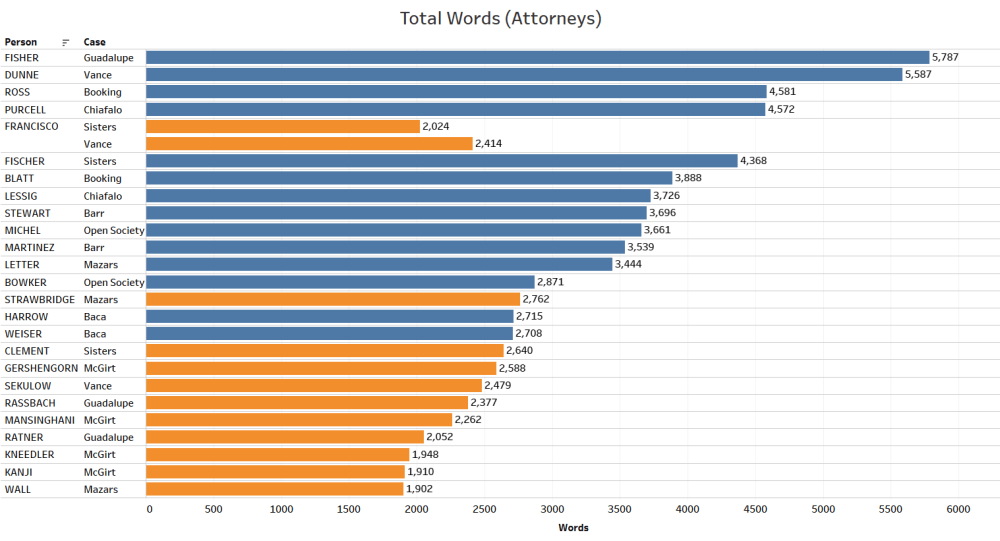
Solicitor General Noel Francisco was the only attorney to argue twice during this sitting — as one of two attorneys for the petitioner in Vance and as one of two advocates for the petitioners in the Little Sisters case. When combined, his total words spoken place him as the fifth most talkative attorney. Jeff Fisher representing the respondents in the Guadalupe School case spoke most of the attorneys during the May sitting followed closely behind by Carey Dunne who represented the respondents in the Vance case. For some context, only four attorneys spoke 4,000 or more words in an argument across the entire 2017 Supreme Court Term. Jeff Fisher had the second largest word count that term with 4,184 in the Koons case placing him only one word behind Adam Unikowsky who spoke 4,185 words in Sveen.
Individual Arguments
Probing the individual arguments the next section looks at who spoke and at what was said. Along with overall speaking statistics, two cases, Vance and McGirt were randomly selected for additional inspection. Three measures are provided for each case: overall word counts for the justices, a word cloud showing the most frequent words used in the arguments, and individual word frequencies for the justices. For Vance and McGirt the words spoken counts are broken down further into words spoken to petitioner and respondent attorneys. The importance of this additional breakdown is described in their respective sections below. Since many of the frequent words from the justices are non-substantive, the word lists were often pared down to find words of substantive interest. The rank order of the word frequencies are also provided to show how far down each word was on a justice’s word frequency list for a case. This is especially important when non-substantive words were removed from the lists. The arguments are analyzed below in the same order in which they were argued.
No. 19–46. United States Patent and Trademark Office et al. v. Booking.com B.V.
Some of the key words that can be extracted from this word cloud include: language, test, goodyear, significance, primary, generic, and cancellation.
The next chart shows the most frequent words spoken by the justices. Since some insignificant words were removed the chart also shows the rank order of each word for a justice or how high a word was on a justice’s list if the list is not entirely sequential.
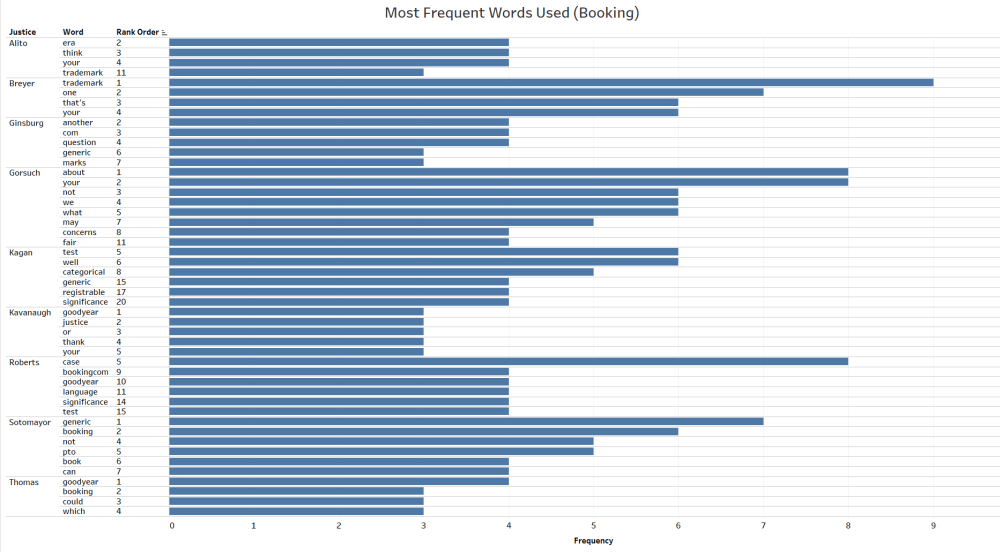
Justice Breyer mentioned “trademark” nine times which was the most frequently used word by any justice. Sotomayor said “generic,” most frequently at seven times. Justices Thomas’ and Kavanaugh’s most frequent word was “Goodyear.” The only other justice with “Goodyear” on his or her list was Chief Justice Roberts.
The next chart tracks total words spoken by justice in these arguments.
Justice Kagan spoke the most followed by Justice Roberts (whose words include those he expended on timekeeping). Justices Gorsuch, Sotomayor, and Breyer also spoke over 400 words apiece with all other justices saying considerably less.
We can see how some of these terms were used from Chief Justice Roberts’ statement on p. 5-6 of the transcripts:
“[C]ounsel, you mentioned the Goodyear case, but you did not quote the language from the trademark statute that is at issue here. That language says that the primary significance of the mark to the public shall be the test for determining whether the mark has become generic.”
No. 19–177. United States Agency for International Development, et al. v. Alliance for Open Society International, Inc., et al.
Some of the more prominent terms in this argument include: foreign, same, entity, domestic, formal, and affiliation.
Breaking these down by the justices we see the following most frequent words spoken.
Justice Alito’s usage of “entity” tops all other word use by a considerable margin. The second most frequently used term by a justice also comes from Alito — “foreign.” Justice Gorsuch’s most frequent term is also “entity.” These are the only two justices with “entity” on the top of their lists. “Foreign” was Justice Roberts’ top word and Justices Ginsburg and Kavanaugh’s second most common word. It was also on Justice Sotomayor’s word list.
Justice Alito provides context to some of these terms from pages 20-21 of the transcripts when he says,
“So the U.S. entity gets the money and the U.S. entity wants to make a sub-grant to a foreign entity, and as I understood your — your position, whether or not the foreign entity can be required to endorse the policy depends on whether it’s legally distinct from the U.S. entity. Is that correct?”
Looking at individual word counts, the justices speech breaks down as follows:
Justices Sotomayor and Alito spoke the most with only two words separating the two. Gorsuch was not far behind with 490 words. Roberts, even with his timekeeping role spoke the fourth most frequently of the justices. Once again Thomas was the most reticent of the justices, speaking a total of only 202 words.
No. 19–431. Little Sisters of the Poor Saints Peter and Paul Home v. Pennsylvania, et al.
As much was said during the Little Sisters arguments, this word cloud is a bit denser than the previous ones. Some of the more prominent words include: exemption, church, honor, think, coverage, employers, and government.
There is substantial variation in the justices’ choices of their most frequent words.
Ginsburg said “women” 14 times which is more than any word for any other justice. Interestingly, this word does not appear on any other justice’s word list.
One instance of how this word came up comes from Ginsburg’s statement on page 8 of the transcripts:
“The glaring feature of what the government has done in expanding this exemption is to toss to the winds entirely Congress’s instruction that women need and shall have seamless, no-cost, comprehensive coverage. Seamless, no-cost, comprehensive coverage.”
The word used second most frequently by a justice was “rule” from Justice Kagan. This word also does not appear on other justices’ top word lists. One word that comes up on a few occasions is “coverage” as it is the third most frequent word on both Justices Ginsburg and Sotomayor’s lists.
Justice Kagan spoke most during these arguments with over 100 words more than the next most talkative justice. Justice Alito was the only other justice with over 700 words and Justice Ginsburg and Roberts make up the only other justices with over 600 words. Justice Thomas spoke the least with over 200 fewer words than the second least talkative justice during these arguments — Justice Sotomayor.
No. 19–631. William P. Barr, Attorney General, et al. v. American Association of Political Consultants, Inc., et al.
Some of the words that appear important to the American Association of Political Consultants argument include: exception, complaining, severability, speech, and unconstitutional.
Justice Thomas employed some of these terms on page 9 of the transcripts when he said,
“…it would seem a bit odd, as you suggest, that we sever the exception, but, here, it doesn’t seem — this remedy doesn’t seem to give anything to Respondent. It doesn’t add any more speech for that for the Respondent.”
Looking at the individual justices’ word lists, we see that “government” appears at the top of Justice Ginsburg’s list and is third on Justice Kagan’s list. We also see that “exemption” is on both Ginsburg and Kagan’s lists while “exception” was one of the top words for Justices Gorsuch, Thomas, and Kavanaugh.
Justices Roberts and Gorsuch spoke most in these arguments followed by Justices Kagan and Kavanaugh. Justice Thomas once again spoke the least.
No. 18–9526. Jimcy McGirt v. Oklahoma
Outside of the names of the attorneys and justices in this case, some of the most common words include: community, Oklahoma, different, reservation, and dependent.
Several of these words appear in Justice Kagan’s statement,
“Mr. Kneedler, I understand you want to support Oklahoma’s position in this case, but just to follow up on Justice Sotomayor’s questions about what Indian — what dependent Indian communities were or were thought to be in 1935, do you think that those concepts were mutually exclusive, a reservation and a dependent Indian community?”
The term “Indian” appears at the top of Justices Kagan and Sotomayor’s list and appears lower down on Justice Kavanaugh’s list. Justices in this case tended to share fewer words with other justices in their word lists. Many of the top words also fail to highlight aspects unique to this case.
The more conservative justices tended to speak more in these arguments as Justices Kavanaugh, Gorsuch, Alito, and Roberts make up four of the top five most talkative justices with Justice Thomas once again the least talkative Justice.
When we break down the justice speech during the petitioner’s and respondent’s arguments we see that the conservative justices tended to dominate both sides, although different justices spoke more during the respective sides’ turns.
Justice Kavanaugh spoke most by a large margin during the petitioner’s argument followed by Justices Alito and Roberts. Justice Gorsuch spoke most during the respondent’s argument followed by Kavanaugh and Sotomayor. Justice Gorsuch spoke third to least of the justices during the petitioner’s argument. This example suggests that predicting the justices votes based on speaking statistics (here is an example of this type of analysis) will be difficult at least in this case.
No. 19–267. Our Lady of Guadalupe School v. Agnes Morrissey-Berru
Some of the more common words in the Guadalupe School arguments were: teachers, different, Catholic, concern, function, and religious.
Justice Alito said “school” 14 times which was the most frequent word used by a justice. Many of the justices also have words rooted in “teaching” and “religion” as Justices Sotomayor and Gorsuch’s top word is “religious” and Justice Ginsburg’s top term is “teacher.”
Justice Breyer used several of these terms in the following:
“Why? Why if it’s a plain teacher and teaches religion too, why is it necessary to keep out of it entirely, even if that teacher or whoever administrator is does discriminate on the basis of handicap?”
Justice Gorsuch spoke most during these arguments followed closely behind by Justice Kagan. While Justice Thomas once again spoke the least, he was only eight words behind Justice Ginsburg in these arguments.
No. 19–715. Donald J. Trump, et al. v. Mazars USA, LLP, et al.
The large word cloud for the Mazars case contains a diverse set of terminology. Important terms include: subpoenas, committees, subject, letter, harassment, personal, and legislation.
As this case deals with the president’s records, it is no surprise that “president” is the top term on several justices lists — Justices Alito, Kagan, and Sotomayor’s. Subpoena is also prominent on several justices lists including Thomas, Kavanaugh, and Alito’s.
This was the first argument where Thomas did not speak the least during the May sitting as he said 11 more words than Justice Ginsburg including the following statement, “Counsel, the — I’m very interested, do you think that there are any implied powers for the Congress to request or to subpoena private documents?” Justices Kagan and Roberts spoke most as they were the only justices with over 800 words.
No. 19–635. Donald J. Trump v. Cyrus R. Vance, Jr., in His Offcial Capacity as District Attorney of the County of New York, et al.
The Vance arguments also led to a word cloud full of insightful terms. These include: standard, special, prosecutor, needs, information, president, and immunity.
As with Mazars “president” was high on several justices word lists in Vance. Chief Justice Roberts used the word “case” more than any other word from any justice. “Information” was Justice Alito’s top word and Justice Sotomayor’s top term was “standard.”
Chief Justice Roberts spoke most in these arguments by a large margin. After Roberts there was a close cluster of total speech from Justices Sotomayor, Kavanaugh, Gorsuch, Breyer, and Alito.
We see some of the interplay between the justices’ remarks as well as the constitutional law elements of the case from Justice Kavanaugh’s statement:
“And I think, in Justice Breyer’s concurrence in Clinton against Jones, he referred to the interest in time and energy distraction, which he drew from Nixon versus Fitzgerald, a different Nixon case, as an independent Article II interest that is distinct from distortion of official decision-making, which would be more the executive privilege kind of interest. Is that the Article II interest you’re zeroing in on, or is it something else?”
When we break down the speech by petitioner and respondent’s arguments we see more of an ideological divide than we saw in the McGirt arguments.
Not surprisingly the more liberal justices tended to speak more during the petitioner’s turn with Justices Sotomayor, Breyer, and Kagan as three of the four most vocal justices. One inference from this is that they are more likely to vote against the petitioner or the position held by the president. Contrastingly, the four most talkative justices during the respondent’s turn were the more conservative Justices Roberts, Kavanaugh, Gorsuch, and Alito.
No. 19–465. Peter B. Chiafalo, Levi Jennet Guerra, and Esther Virginia John v. Washington.
Some of the more common words in the Chiafalo arguments were: electors, state, popular, vote, and circumstances.
Justices Sotomayor and Breyer were the two most talkative justices during these arguments. Justice Breyer honed in on some of the important elements of this case in his questioning including:
“What’s the difference between that and this situation, where they say, you must promise to vote for the person who wins the most votes, and then he gets to the room, and in that room, he doesn’t live up to that requirement, just as he didn’t live up to the requirement that he be a resident of the state?”
This was another case where Justice Thomas spoke more than Justice Ginsburg and since Justice Ginsburg spoke fewer than 100 words in this argument, Justice Thomas actually spoke over 150 words more than Justice Ginsburg.
No. 19–518. Colorado Department of State v. Micheal Baca, et al.
In Baca, the other faithless electors case, many similar terms appear as were prominent in the Chiafalo arguments including: electors, power, remove, vote, and candidate.
Justice Alito used the term “electors” more than any other justice used any term and “electors” appears on several other justices’ top word lists. Other examples of important top words include Justice Gorsuch’s use of “vote” and Justice Thomas’ use of “accountability.”
Justice Gorsuch uses several important terms in the following passage from page 24 of the transcripts:
“If — if states enjoy plenary power to remove electors, what would prohibit them from passing a law to say — for example, to say that — that all electors have to — have to vote for presidents — presidential candidates who support certain positions or who have done certain things or who have visited the state.”
Justices Gorsuch and Roberts spoke most during the Baca arguments with only five words separating the two. There are several hundred words that separate these justices from the next most talkative justices: Justices Breyer, Alito, and Kagan.
In total, Roberts and Kagan both spoke most in three arguments each with Sotomayor speaking most in two arguments, and Kavanaugh and Gorsuch speaking most in one argument each. If we assume that Roberts spoke at least 50 words per argument as timekeeper, then Roberts only topped the speaking list in one argument (Vance), while Gorsuch moves into the top spot in three arguments. At the other end of the spectrum, Justice Thomas spoke least in seven of the arguments while Justice Ginsburg spoke least in the other three arguments from the May sitting.





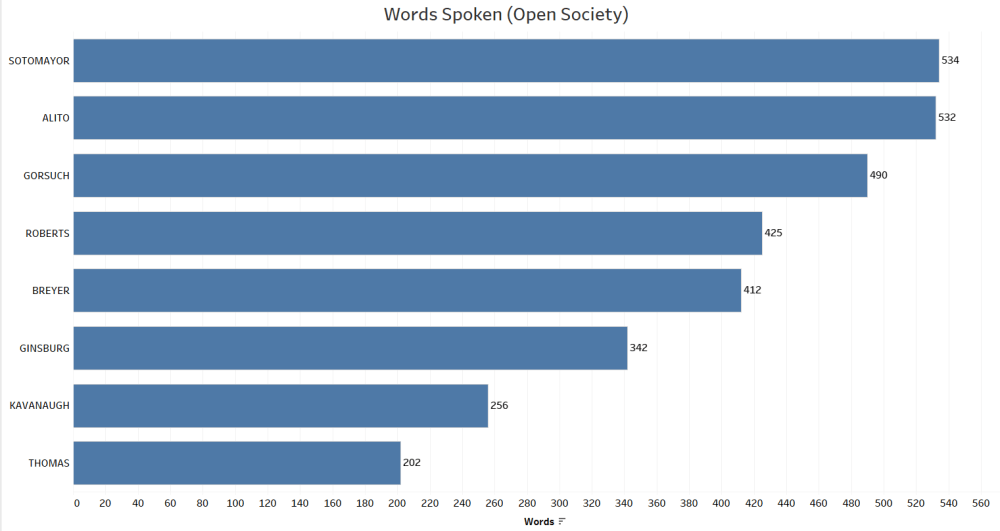
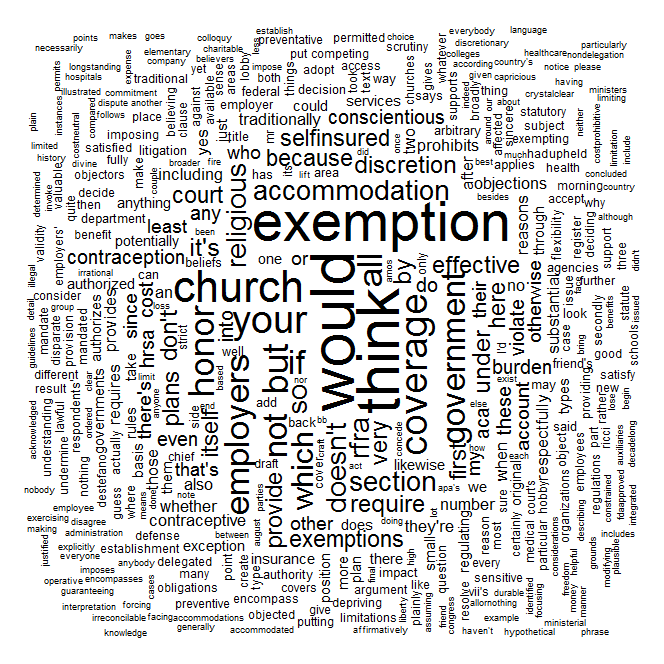

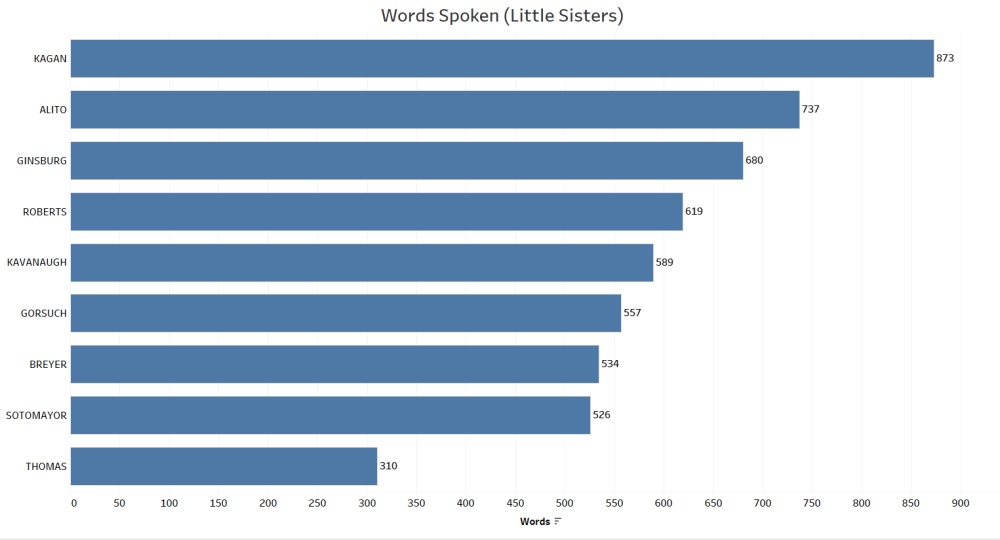
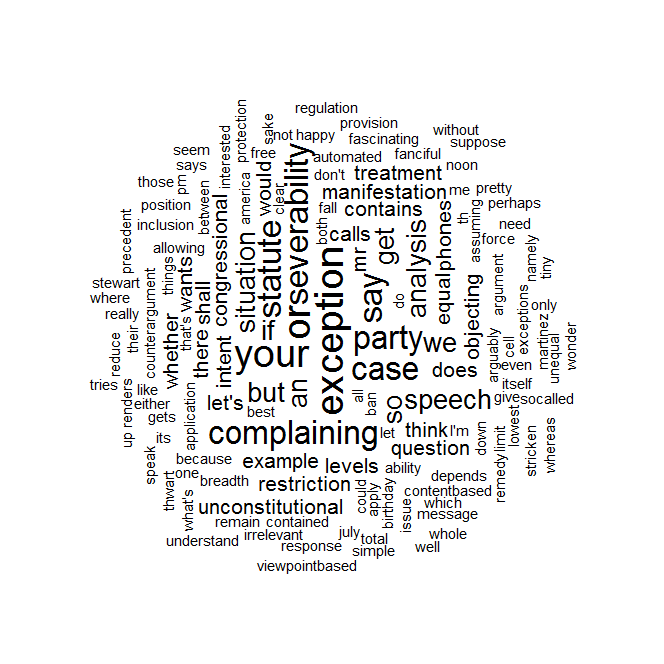

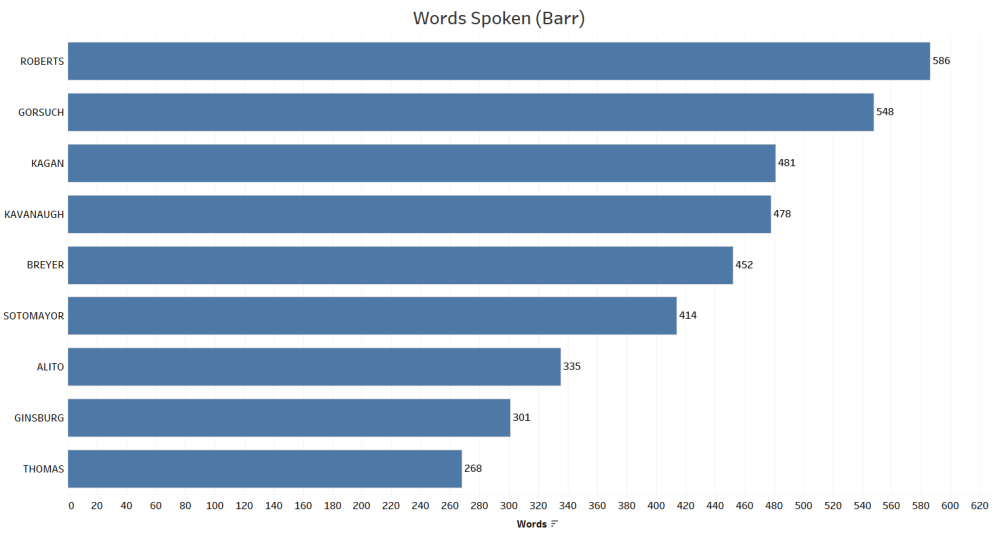
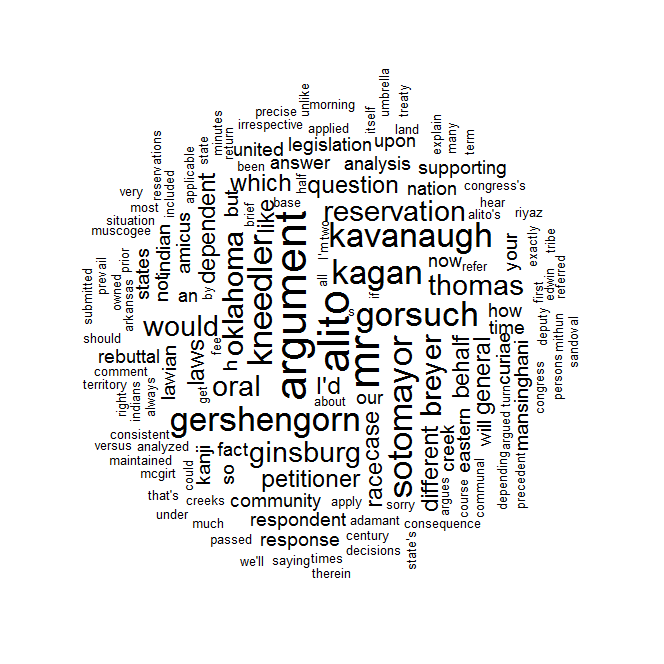

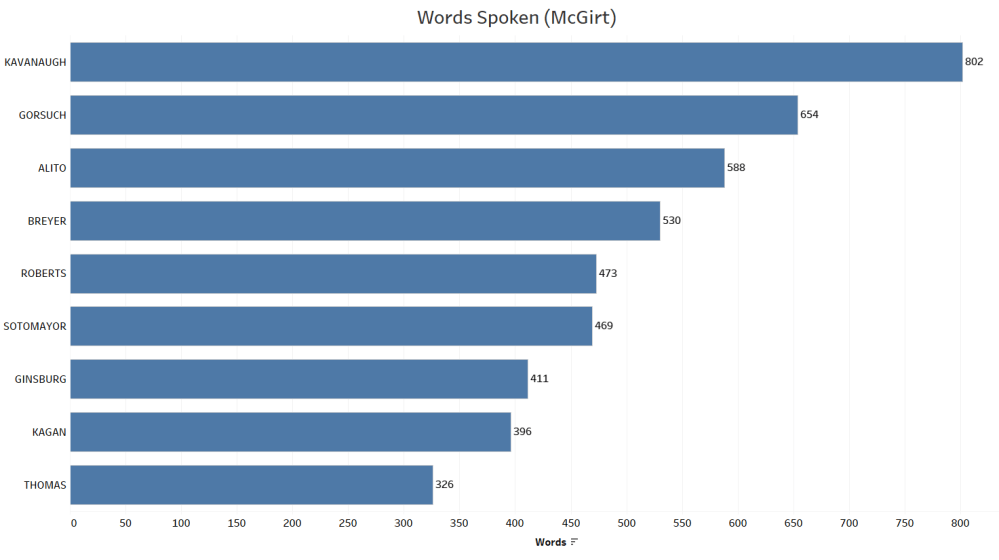

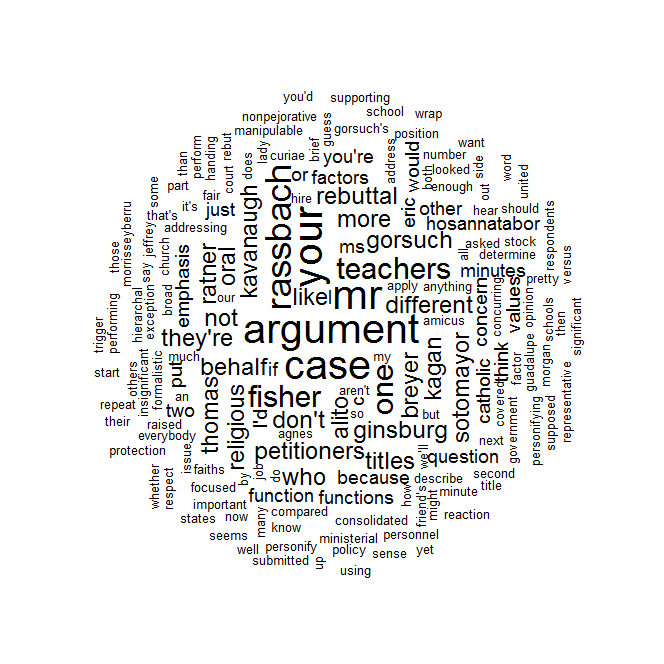
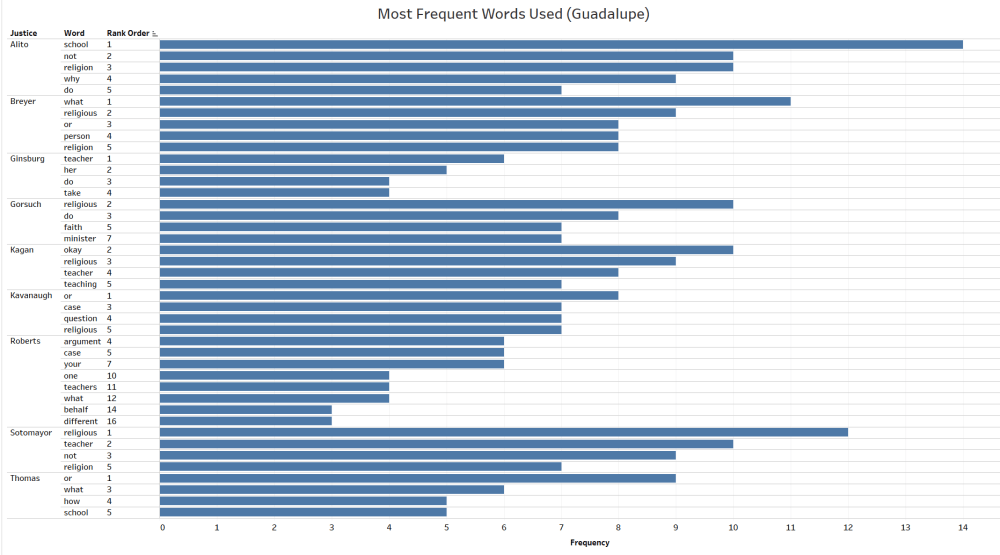

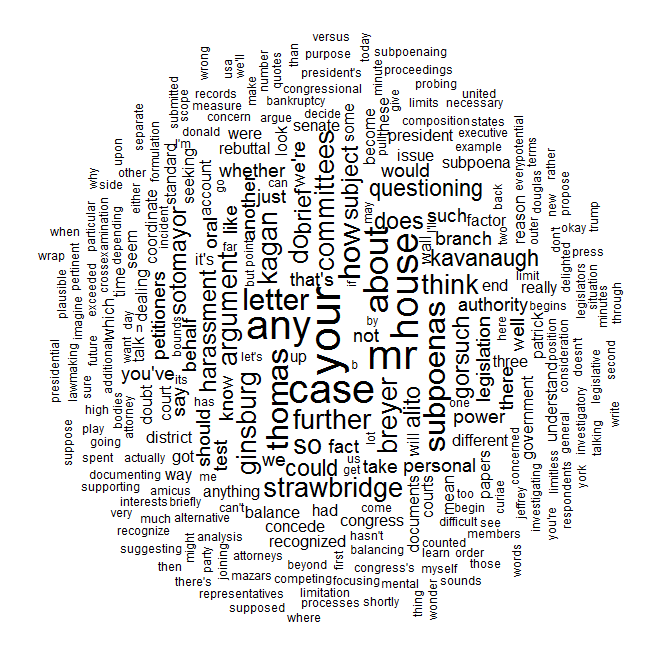
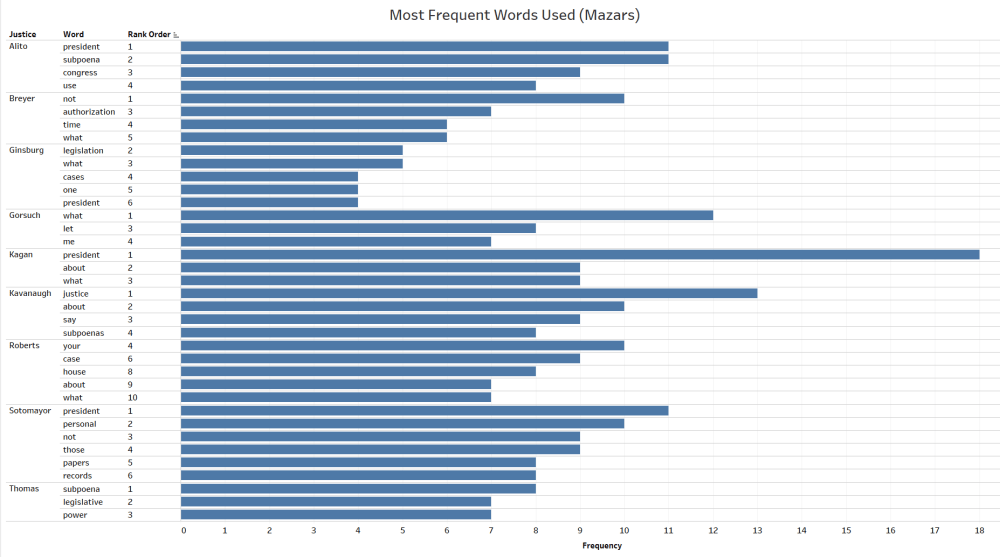
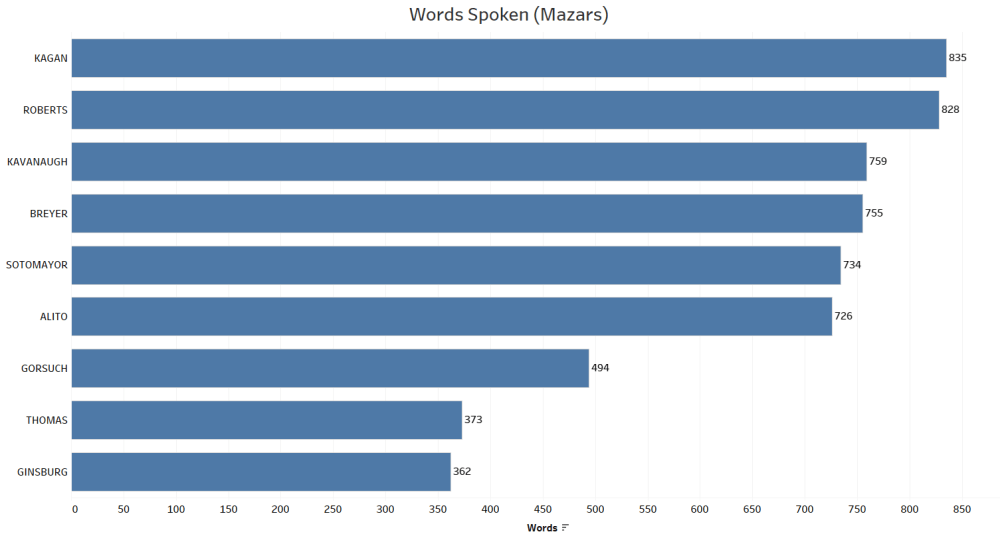
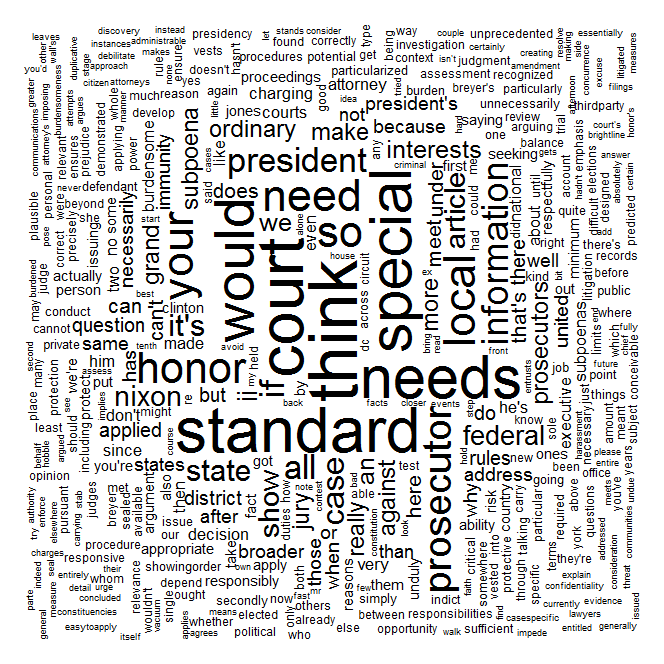

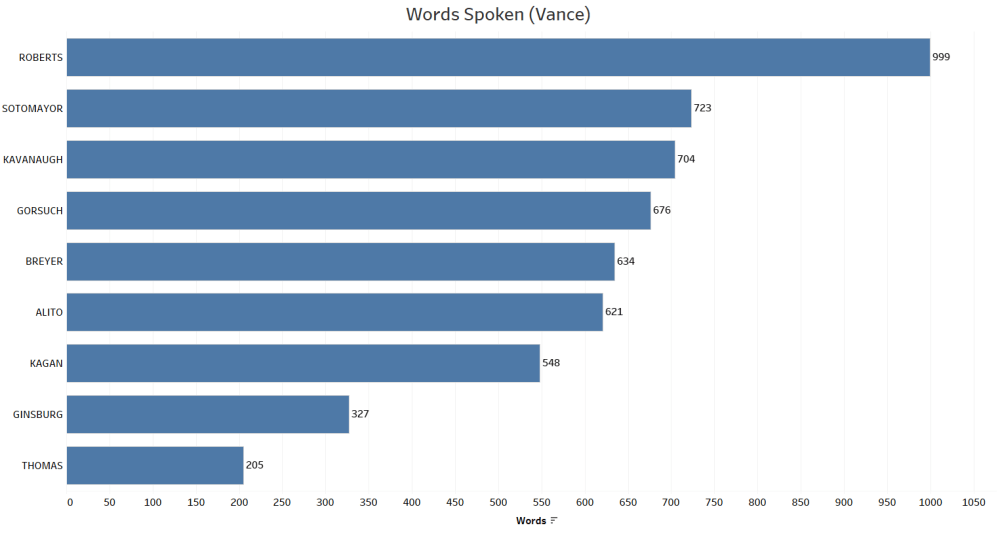
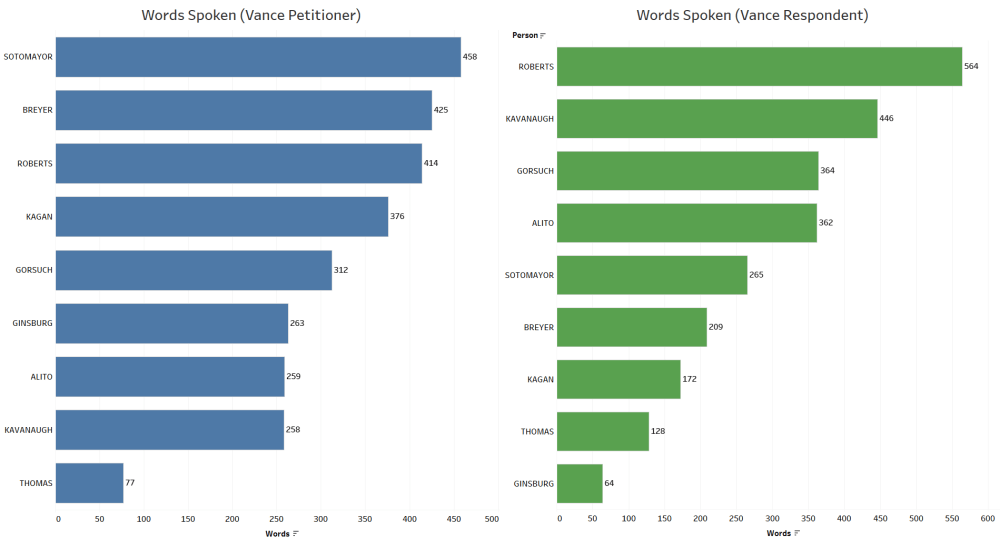

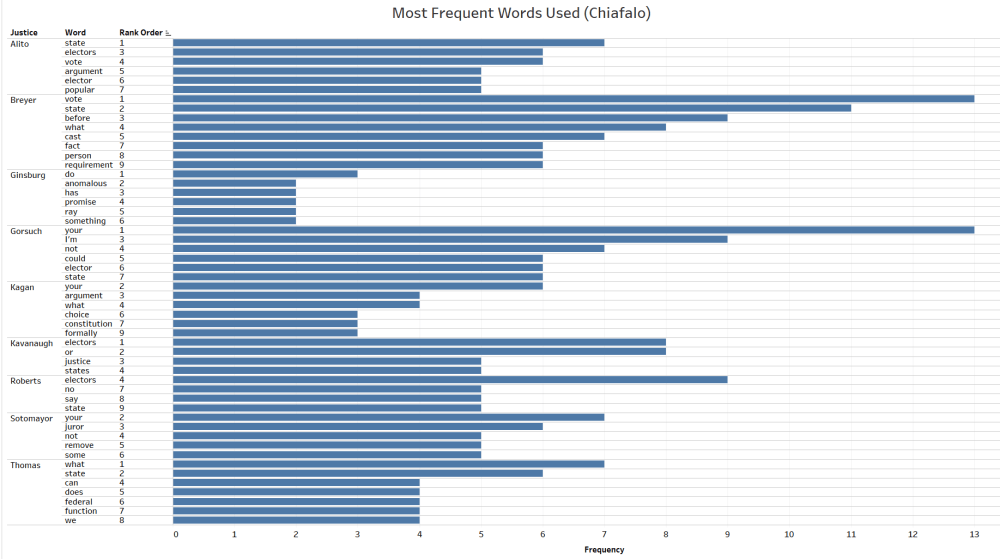
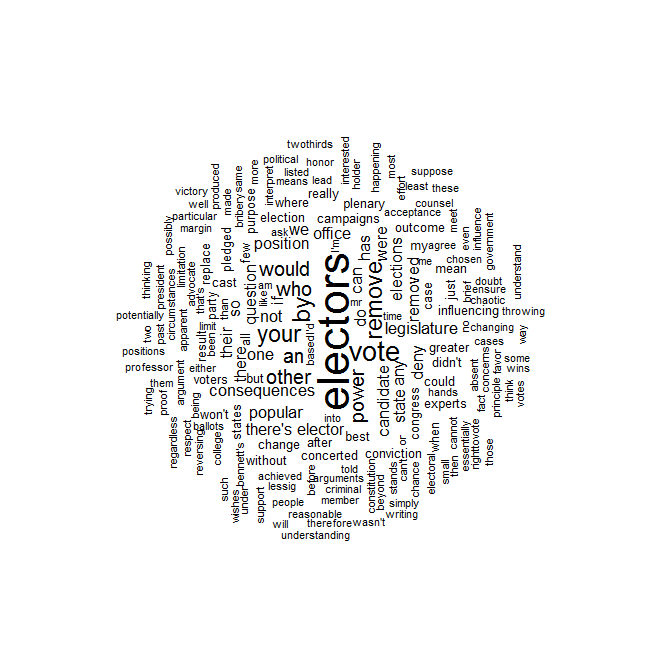
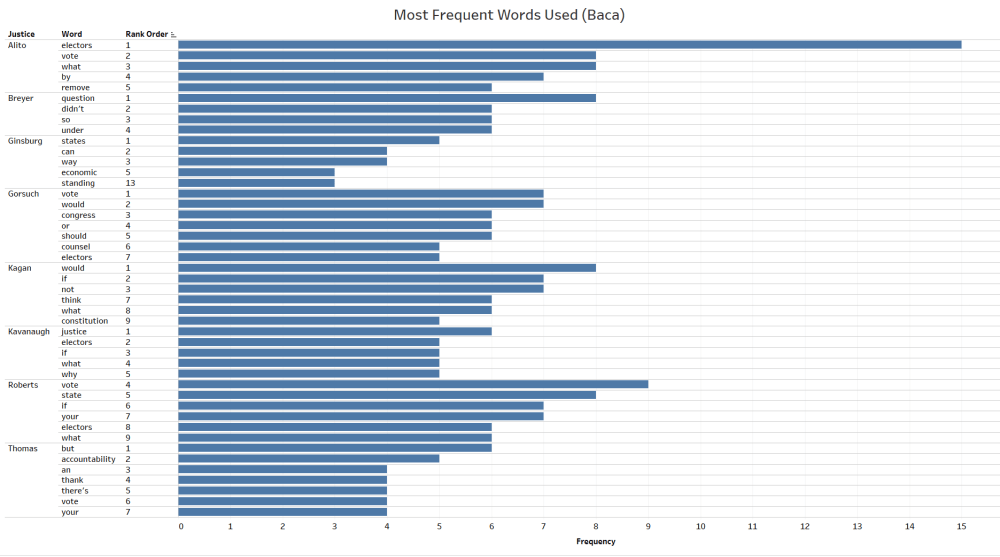
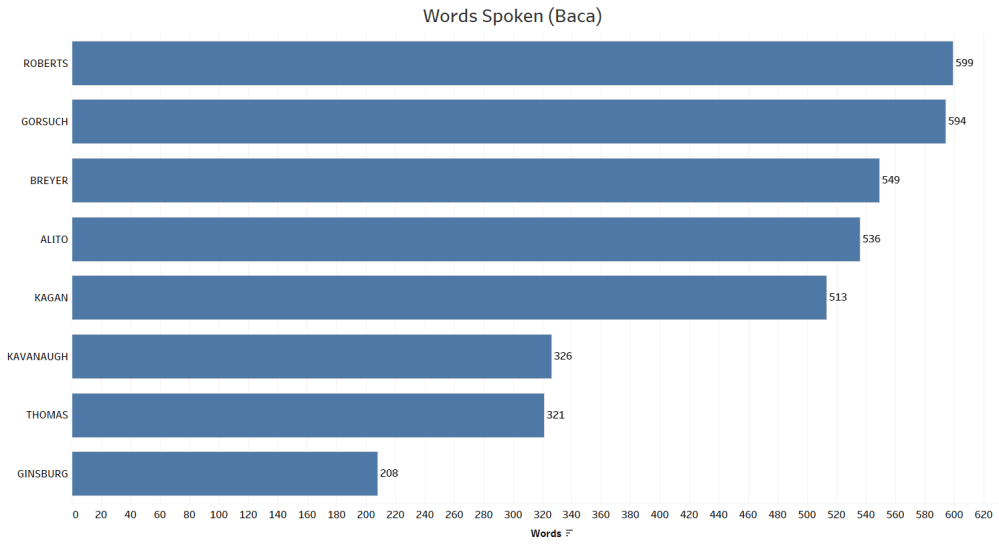
Ginsberg was participating from the hospital, perhaps her word count would have been higher were she well.
LikeLike